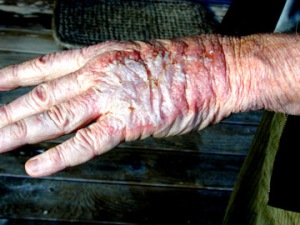Natural News
One of the side effects of chemotherapy is, ironically, cancer. The cancer doctors don’t say much about it, but it’s printed right on the chemo drug warning labels (in small print, of course). If you go into a cancer treatment clinic with one type of cancer, and you allow yourself to be injected with chemotherapy chemicals, you will often develop a second type of cancer as a result. Your oncologist will often claim to have successfully treated your first cancer even while you develop a second or third cancer directly caused by the chemo used to treat the original cancer.
There’s nothing like cancer-causing chemotherapy to boost repeat business, huh?
During all this, the pharmacists are peddling these toxic chemotherapy chemicals to their customers as if they were medicine (which they aren’t). While preparing these toxic chemical prescriptions, it turns out that pharmacists are exposing themselves to cancer-causing chemotherapy agents in the process. And because of that, pharmacists are giving themselves cancer… and they’re dying from it.
Why pharmacists are dying of cancer?
People who live in glass houses should never throw stones, they say. And you might similarly say that pharmacists who deal in poison shouldn’t be surprised to one day discover they are killing themselves with it.
Chemotherapy drugs are extremely toxic to the human body, and they are readily absorbed through the skin. The very idea that they are even used in modern medicine is almost laughable if it weren’t so downright disturbing and sad that hundreds of thousands of people are killed each year around the world by chemotherapy drugs.
Now you can add pharmacists to that statistic. For decades, they simply looked the other way, pretending they were playing a valuable role in our system of “modern” medicine, not admitting they were actually doling out chemicals that killed people. Now, the sobering truth has struck them hard: They are in the business of death, and it is killing them off, one by one.
The Seattle Times now reports the story of Sue Crump, a veteran pharmacist of two decades who spent much of her time dispensing chemotherapy drugs. Sue died last September of pancreatic cancer, and one of her dying wishes was that the truth would be told about how her on-the-job exposure to chemotherapy chemicals contributed to her own cancer.
Second-hand chemo
The Occupational Safety and Health Association (OSHA), it turns out, does not regulate workplace exposure to toxic, cancer-causing chemotherapy chemicals. At first glance, that seems surprising, since OSHA regulates workplace exposure to far less harmful chemicals. Why not chemo?
The answer is because the toxicity of chemotherapy has long been ignored by virtually everyone in medicine and the federal government. It has always been assumed harmless or even “safe” just because it’s used as a kind of far-fetched “medicine” to treat cancer. This, despite the fact that chemotherapy is a derivative of the mustard gas used against enemy soldiers in World War I. Truthfully, chemotherapy has more in common with chemicals weapons than any legitimate medicine.
So today, while workers are protected from secondhand smoke in offices across the country, pharmacists are still being exposed every single day to toxic, cancer-causing chemicals that OSHA seems to just ignore. The agency has only issued one citation in the last decade to a hospital for inadequate safety handling of toxic chemotherapy drugs.
As the Seattle Times reports, “A just-completed study from the U.S. Centers for Disease Control (CDC) — 10 years in the making and the largest to date — confirms that chemo continues to contaminate the work spaces where it’s used and in some cases is still being found in the urine of those who handle it…”
That same article goes on to report more pharmacists, veterinarians and nurses who are dead or dying from chemotherapy exposure:
• Bruce Harrison of St. Louis (cancer in his 50′s, now dead)
• Karen Lewis of Baltimore (cancer in her 50′s, still living)
• Brett Cordes of Scottsdale, Arizona (cancer at age 35, still living)
• Sally Giles of Vancouver, B.C. (cancer in her 40′s, now dead)
The great contradiction in cancer treatments
As the Seattle Times reports:
“Danish epidemiologists used cancer-registry data from the 1940s through the late 1980s to first report a significantly increased risk of leukemia among oncology nurses and, later, physicians. Last year, another Danish study of more than 92,000 nurses found an elevated risk for breast, thyroid, nervous-system and brain cancers.”
The story goes on to report how new safety rules are being put in place across the industry to protect pharmacists, veterinarians, nurses and doctors from toxic chemotherapy chemicals. But even the Seattle Times, which deserves credit for running this story, misses the bigger point:
If these chemicals are so dangerous to the doctors, nurses and pharmacists dispensing them, how can they be considered “safe enough” to inject into patients who are already dying from cancer?
It’s a serious question. After all, if nurses can become violently ill after merely spilling chemotherapy chemicals on themselves (it’s true), then what effect do you suppose these chemicals have when injected into patients?
The cancer industry, though, has never stopped injecting patients long enough to ask the commonsense question: Why are we in the business of dispensing poison in the first place? Poison, after all, isn’t medicine. Not when dispensed in its full potency, anyway.
The whole idea of “safety” in the cancer industry is to find new ways to protect the health care workers from the extremely dangerous chemicals they’re still injecting into the bodies of patients. Something is clearly wrong with this picture… if health care workers need to be protected from this stuff, why not protect the patients from it, too?
Nobody ever died from handling herbs
In contrast to all this, consider the truthful observation that no naturopath ever died from handling medicinal herb, homeopathy remedies or nutritional supplements. These natural therapies are good for patients, and as a bonus, you don’t have to wear a chemical suit to handle them.
Furthermore, medicinal herbs, supplements and natural remedies don’t cause cancer. They support and protect the immune system rather than destroying it. So they make patients healthier and more resilient rather than weaker and fragile.
But herbs, supplements and natural remedies don’t earn much money for the cancer industry. Only the highly-toxic patented chemotherapy drugs bring in the big bucks. So that’s what they deal in – poison for the patients. And when you deal in poison, some of it always splashes back onto you.
Chemotherapy doesn’t work
Beyond this whole issue of pharmacists and health care workers dying from exposure to secondhand chemotherapy, there’s the issue of whether chemotherapy actually works in the first place. Scientifically speaking, if you take a good, hard look at what the published studies actually say, chemotherapy is only effective at treating less than two percent of the cancers that exist. And that two percent does not include breast cancer or prostate cancer.
Yet chemotherapy is routinely used to “treat” breast cancer even though it offers no benefit to breast cancer patients. In effect, the cancer industry is engaged in a criminal treatment hoax that promises to make you healthier but actually gives you even more cancer — which is great for repeat business, but terrible for the cancer patients who suffer under it.
The level of quackery at work right now in the cancer industry is simply astonishing. You would think that if doctors and pharmacists were dishing out these chemicals to patients, they would make sure there was some sort of legitimate science to back them up. But they haven’t. The science doesn’t exist. Chemotherapy doesn’t work at anything other than causing cancer — and it accomplishes that indiscriminately, damaging any person it comes into contact with. Merely touching chemotherapy chemicals is dangerous for your health.
So if you’re considering chemotherapy for yourself, think about this long and hard: If chemotherapy is so dangerous that it’s giving the pharmacists cancer just from touching it, why on earth would you want to inject it into your body?
This is not an idle question. It is perhaps the most important question of all for someone considering conventional cancer treatment using chemotherapy. The question is essentially this: If chemotherapy causes cancer, how can it treat cancer?
Treating cancer with chemotherapy is like treating alcoholism with vodka. It’s like treating heart disease with cheese, or like treating diabetes with high-fructose corn syrup. Cancer cannot be cured by the very thing that causes it.
And to those who deal in poison, watch out for the cause-and-effect laws of biology. If you deal in chemotherapy chemicals, don’t be surprised if you get cancer one day. If you deal in chemical pesticides, don’t be surprised if you get Alzheimer’s. If you’re a dentist installing mercury fillings in the mouths of clients, don’t be surprised if one day you just go stark raving mad (because mercury causes insanity, and dentists breathe in mercury vapor thrown into the air from their drills).
If you work around chemicals, they will eventually impact your health, and never in a good way. There’s a karmic element in all this, too: If you spend your life dishing out chemotherapy drugs as a pharmacist, you have a lot to answer for. You have been an enabler of a very real chemical holocaust against the people. Don’t be surprised if that holocaust turns against you one day. Karma tends to work that way. Cause and effect is a universal law that cannot be escaped.
And if you’re a cancer patient, I urge you to think twice about the toxicity of anything you might allow in your body. If you are trying to HEAL your body, why would you allow yourself to be poisoned with a chemical that causes cancer?
Don’t let some cancer doctor talk you into chemotherapy using his fear tactics. They’re good at that. So next time he insists that you take some chemotherapy, ask him to drink some first. If your oncologist isn’t willing to drink chemotherapy in front of you to prove it’s safe, why on earth would you agree to have it injected in your body?





 y researchers from Imperial College London and published in the British Medical Journal.
y researchers from Imperial College London and published in the British Medical Journal.